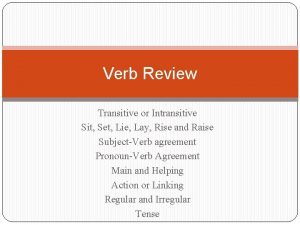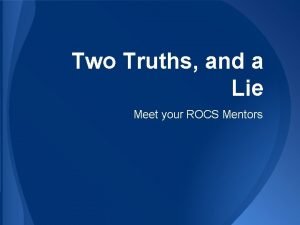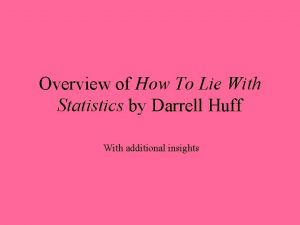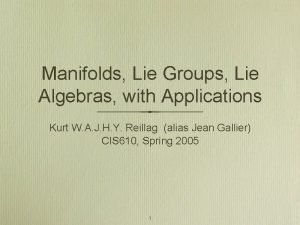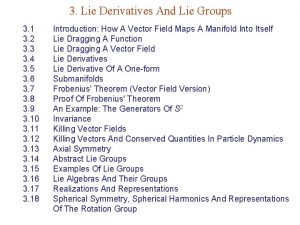Simple Groups of Lie Type David Renardy Simple











- Slides: 11

Simple Groups of Lie Type David Renardy

Simple Groups Simple Group- A nontrivial group whose only normal subgroups are itself and the trivial subgroup. Simple groups are thought to be classified as either: ▪ ▪ Cyclic groups of prime order (Ex. G=<p>) Alternating groups of degree at least 5. (Ex. A 5 ) Groups of Lie Type (Ex. E 8 ) One of the 26 Sporadic groups (Ex. The Monster) First complete proof in the early 90’s, 2 nd Generation proof running around 5, 000 pages.

Lie Groups Named after Sophus Lie (1842 -1899) Definition: A group which is a differentiable manifold and whose operations are differentiable. Manifold- A mathematical space where every point has a neighborhood representing Euclidean space. These neighborhoods can be considered “maps” and the representation of the entire manifold, an “atlas” (Ex. Using maps when the earth is a sphere) Differentiable Manifolds-Manifolds where transformations between maps are all differentiable.

Lie Groups (cont’d) Examples: Points on the Real line under addition A circle with arbitrary identity point and multiplication by Θ mod 2π representing the rotation of the circle by Θ radians. The Orthogonal group (set of all orthogonal nxn matrices. ) Standard Model in particle physics U(1)×SU(2)×SU(3)

Simple Lie Groups Definition: A connected lie group that is also simple. Connected: Topological concept, cannot be broken into disjoint nonempty closed sets. Lie-Type Groups- Many Lie groups can be defined as subgroups of a matrix group. The analogous subgroups where the matrices are taken over a finite field are called Lie. Type Groups. Lie Algebra- Algebraic structure of Lie groups. A vector space over a field with a binary operation satisfying: Bilinearity [ux+vy, w]=u[x, w]+v[y, w] Anticommutativity [x, y]=-[y, x] [x, x]=0 The Jacobi Identity [x, (y, z)]+[y, (z, x)]+[z, (x, y)]=0

Classification of Simple Lie Groups Infinite families An series corresponds to the Special Unital Groups SU(n+1) (nxn unitary matrices with unit determinant) Bn series corresponds to the Special Orthogonal Group SO(2 n+1) (nxn orthogonal matrices with unit determinatnt) Cn series corresponds to the Symplectic (quaternionic unitary) group Sp(2 n) Dn series corresponds to the Special Orthogonal Group SO(2 n)

Exceptional Cases G 2 has rank 2 and dimension 14 F 4 has rank 4 and dimension 52 E 6 has rank 6 and dimension 78 E 7, has rank 7 and dimension 133 E 8, has rank 8 and dimension 248

Simple Groups of Lie Type Classical Groups Special Linear, orthogonal, symplectic, or unitary group. Chevalley Groups Defined Simple Groups of Lie Type over the integers by constructing a Chevalley basis. Steinberg Groups Completed the classical groups with unitary groups and split orthogonal groups ▪ ▪ the unitary groups 2 An, from the order 2 automorphism of An; further orthogonal groups 2 Dn, from the order 2 automorphism of Dn; the new series 2 E 6, from the order 2 automorphism of E 6; the new series 3 D 4, from the order 3 automorphism of D 4.

E 8 We can represent groups of Lie type by their “root system” or a set of vectors spanning Rn where n is the rank of the Lie algebra, that satisfy certain geometric constraints. The E 8 group can be represented in an “even coordinate system” of R 8 as all vectors with length √ 2 with coordinates integers or half-integers and the sum of all coordinates even. This gives 240 root vectors. (± 1, 0, 0, 0, 0) gives 112 root vectors by permutation of coordinates (8!/(2!*6!) *4 (for signs)) (± 1/2, ± 1/2, ± 1/2) gives 128 root vectors by switching the signs of the coordinates (2^8/2)

Science and E 8 Applications in Theoretical Physics relate to String Theory and “supergravity” “The group E 8×E 8 (the Cartesian product of two copies of E 8) serves as the gauge group of one of the two types of heterotic string and is one of two anomaly-free gauge groups that can be coupled to the N = 1 supergravity in 10 dimensions. ”

Sources http: //cache. eb. com/eb/image? id=2106&rend. Type. Id= 4 http: //aimath. org/E 8/images/e 8 plane 2 a. jpg http: //www. mpagarching. mpg. de/galform/press/seq. D_063 a_small. jpg http: //superstruny. aspweb. cz/images/fyzika/aether/h oneycomb. gif Wikipedia. org Mathworld. com Aschbacher, Michael. The Finite Simple Groups and Their Classification. United States: Yale University, 1980.
 How are ethnic groups and religious groups related
How are ethnic groups and religious groups related Make the lie big make it simple
Make the lie big make it simple Make the lie big make it simple
Make the lie big make it simple Structures are laid-back and undefined.
Structures are laid-back and undefined. Lay lie laid
Lay lie laid Lie transitive or intransitive
Lie transitive or intransitive Love island two truths and a lie answers
Love island two truths and a lie answers Tie in present continuous
Tie in present continuous Poetry about lies
Poetry about lies It is a segment whose endpoints are on the circle.
It is a segment whose endpoints are on the circle. How to lie with statistics chapter 1 summary
How to lie with statistics chapter 1 summary Lie lse pompier
Lie lse pompier





